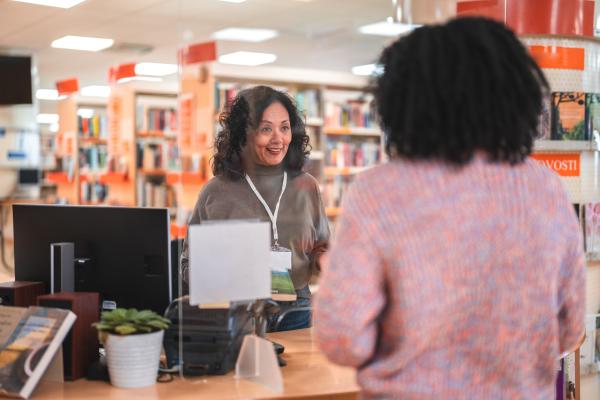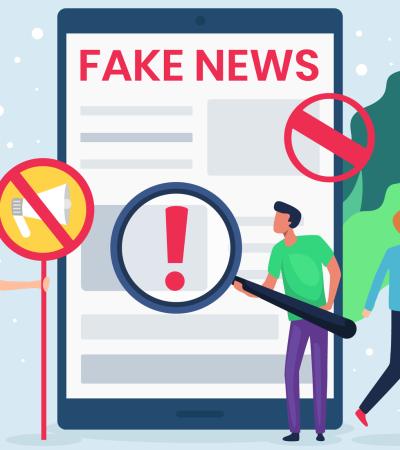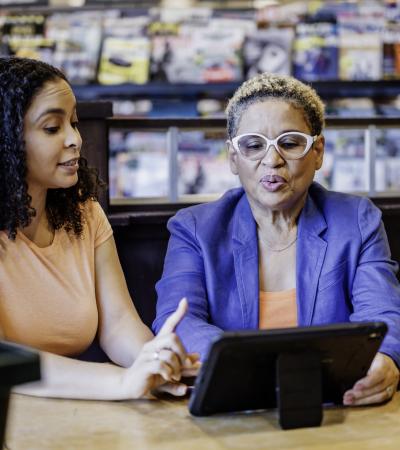One of the best places to teach media literacy is at the point of need, where the users are.
Most library interactions occur during the delivery of services, such as reference interviews, technology classes and interactions at the circulation desk. Consider the following five ways to incorporate small lessons about media literacy into your regular services.
>>The content of this article is taken from the free programming guide "Media Literacy for Adults: Architecture of the Internet">>
1. Service desk handout

A service desk handout can provide a glossary of terms related to the architecture of the internet. Define the following terms: filter bubbles, cookies, confirmation bias, search engines, algorithms and web infrastructure.
Aside from definitions, include a “call-out” box that explains—in the plainest language—why knowledge of the architecture of the internet is important.
See definitions on pages 10 - 11 of the guide for reference.
2. LibGuide
Libraries might also want to create and direct patrons to a LibGuide that covers architecture of the internet concepts. For example, this LibGuide page from the Briggs Library at South Dakota State University is included in the Media Literacy section of a research guide. This LibGuide page from ECPI Universities features a video on filter bubbles.
3. Reference interviews
In the course of a reference interview, there are several points where you can inject information related to architecture of the internet.
- If you're using a search engine to find information with a patron, use the opportunity to explain the factors that influence the results, such as our current location, and possibly, our past search history.
- If you and a patron are looking at an online news article with embedded advertising, discuss why that particular ad may be visible, such as your physical location, and the target audience of the site.
- Take the opportunity to model lateral reading: to investigate the validity of an information source, leave the webpage and open a new browser tab to see what another, trusted website says about the source in question.
- Provide one-on-one support. Some libraries have found success by calling these sessions “Tech Office Hours” or “Digital Tutoring” and offering them at various times throughout the week. Pull in staff and tech-savvy volunteers to provide one-on-one support to patrons for questions pertaining to digital literacy and navigating the internet. These one-off sessions offer patrons guidance and provide answers to specific questions that boost their digital confidence and competence.
- If you’re teaching basic computer classes (especially ones that offer an introduction to the internet), be sure to help your attendees understand how the internet works and how it affects them, including echo chambers, algorithms, and cookies.
4. Public service desk
Whatever your library calls it—“circulation,” the “information desk,” or “user services”—your public service desks are places for quick pathfinding and decision-making. They are also excellent places to impart knowledge about the architecture of the internet. Here are some ways to incorporate key concepts into common public service desk interactions.
- If a patron asks you for help finding information from an untrustworthy source, discuss how they arrived at choosing the source, why they trust it, and who’s behind it. Ask them what sources they’ve used in the past for their topic. Explain why verification of information from the source they’ve chosen may be problematic. You can also sit down with them at a computer and discuss search results from various platforms (databases, the internet), why they are getting certain results, and how the internet influences our results.
- When helping a patron set up or renew a library card, or during library tours or orientations, discuss how the library protects patron privacy and what privacy measures are in place when they’re accessing their library account online or using library tech and the internet.
- If your library offers technology equipment (laptops, WiFi hotspots, etc.) for checkout, this can be a good opportunity to discuss online safety and privacy measures on shared equipment.
If a patron wants to share their political opinion, you might be likely to say something like, “We don’t talk about politics.” Instead, consider asking, “Where did you find that information?” or “Can I help you find more information on that subject?” to turn the conversation to media literacy and begin a conversation about echo chambers or algorithms. For example, a patron might say, “I saw it on Facebook,” which offers an easy segue into how Facebook works, why you need to validate sources, and how.
5. Technology help
During interactions with patrons about library technology, especially those who are novices or uncomfortable with digital tools, take the opportunity to introduce architecture of the internet terms along with other basic skills and concepts.
- When helping a patron set up an email account, discuss how email servers are owned by some of the same companies that libraries use to search, such as Gmail being owned by Google. If they search for something on Google, for example, it might show up as an ad in their Gmail account, or in their Instagram feed, due to tracking across internet platforms. If people sign up to receive emails from a particular website or company, such as a newsletter or notices about sales, this will affect the ads they see and the way their search results come up in Google. If they visit a wellness website and sign up for emails, for example, they’re more likely to see ads on wellness-related topics on other platforms, and when they search on Google, might get results in a different order or different results than another internet user.
- When teaching a patron about social media, take a moment to discuss the platform’s terms of service and privacy settings, and how internet platforms use personal information. When users gain access to a service on a platform, especially one that is free, they essentially “pay” for that service through collection of their personal data. And much of this collection occurs without them knowing explicitly that it is happening, although they have essentially signed a document (a terms of service agreement) that permits the platform to collect this information for whatever uses it deems necessary.
- When demonstrating how to use the library’s catalog or databases, including those controlled by outside companies rather than the library, explain what algorithms are, and that the website resources patrons use to search for information are influenced by algorithms that determine the kinds of answers presented to them. Although architecture of the internet can be a complex media literacy topic, internet users need to understand how what we don’t see online deeply affects what we do see on our screens. Libraries can provide opportunities through programming or regular one-on-one services provided to the public to help patrons understand the bones of the internet and how the structures and processes behind the screen control how we receive vital information.
For more program ideas and background information on the history of the internet and media literacy topics, download the free Architecture of the Internet Programming Guide.
Media Literacy Education in Libraries for Adult Audiences is a project conducted by the ALA Public Programs Office in collaboration with Knology, a nonprofit research organization that produces practical social science for a better world. It was made possible in part by the Institute of Museum and Library Services grant number LG-13-19-0089-19.



